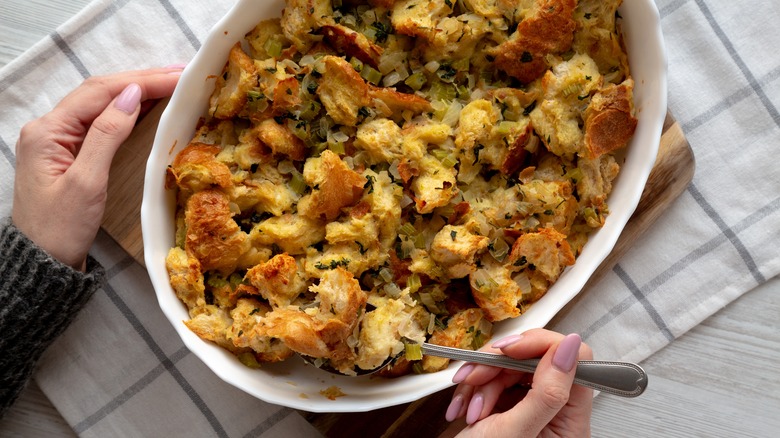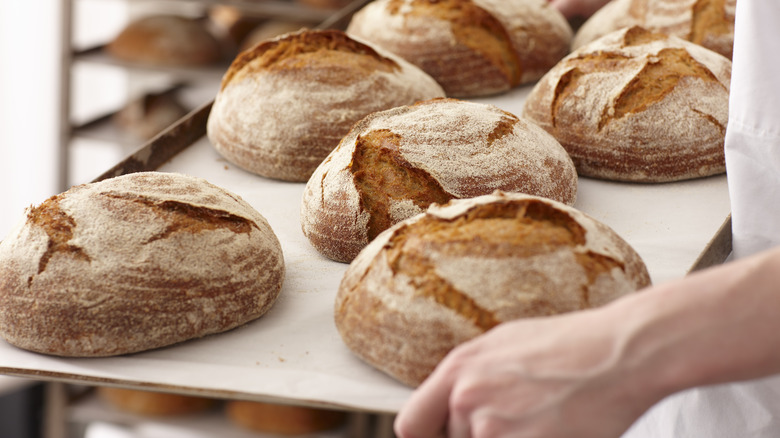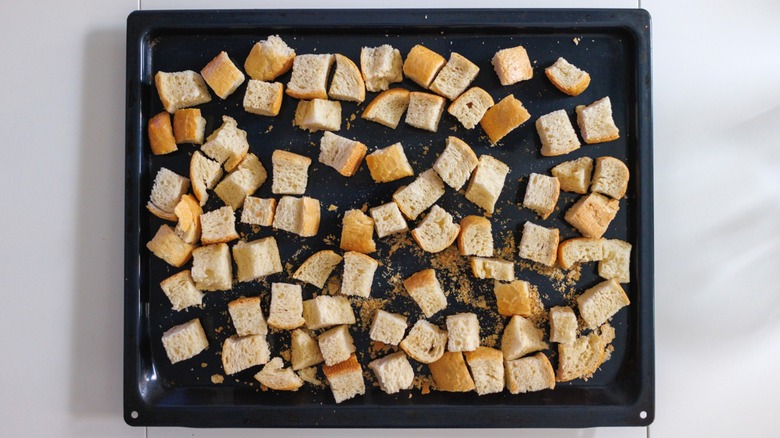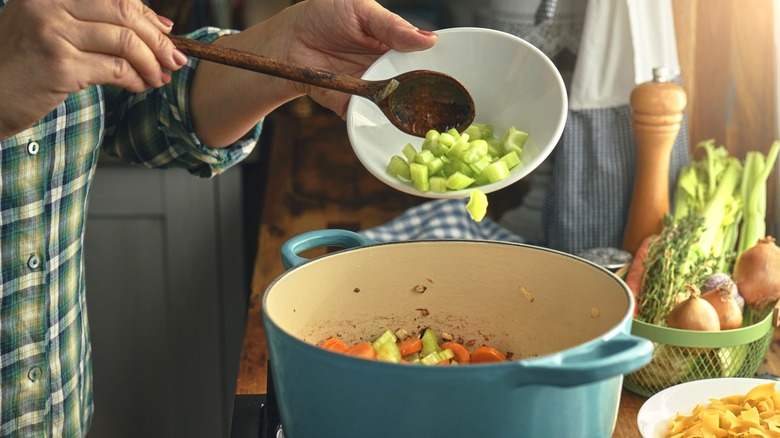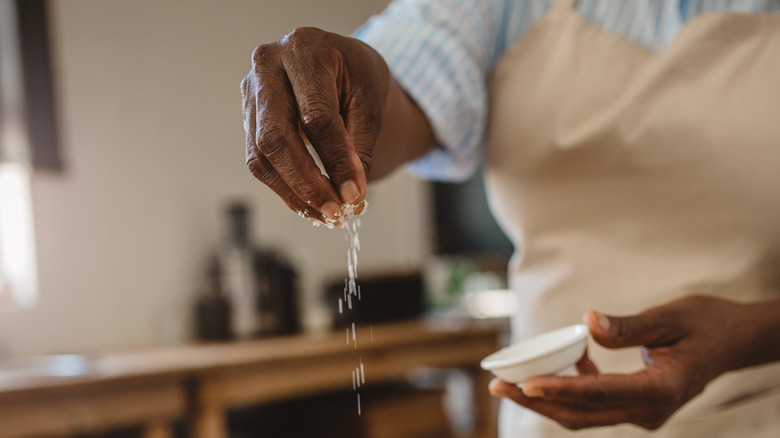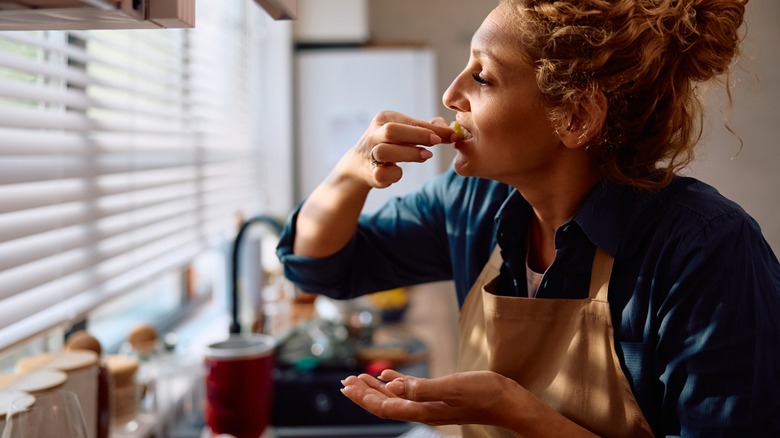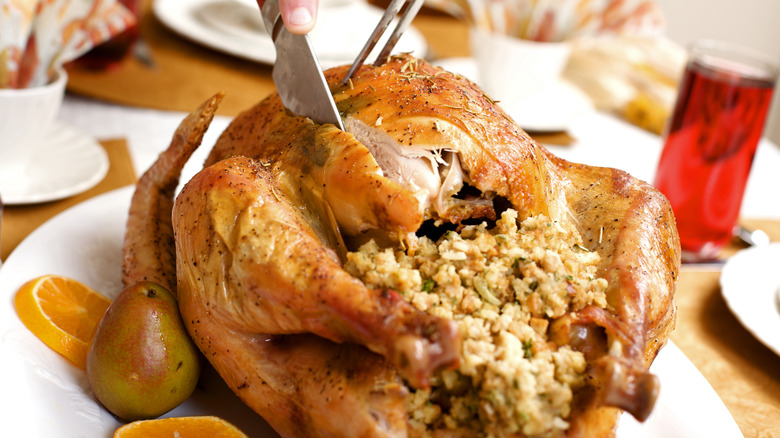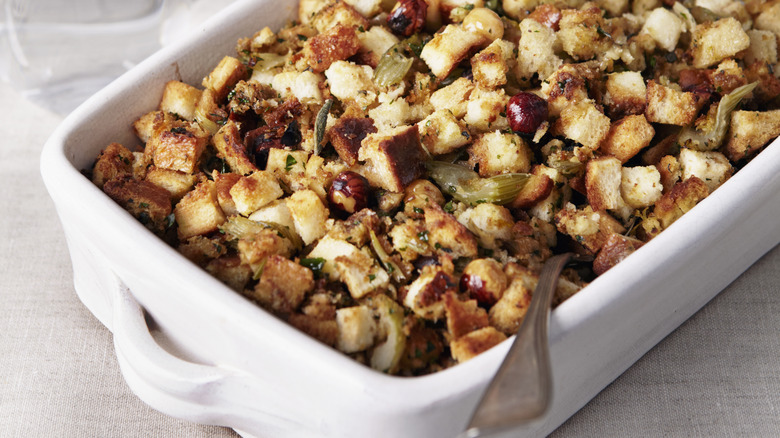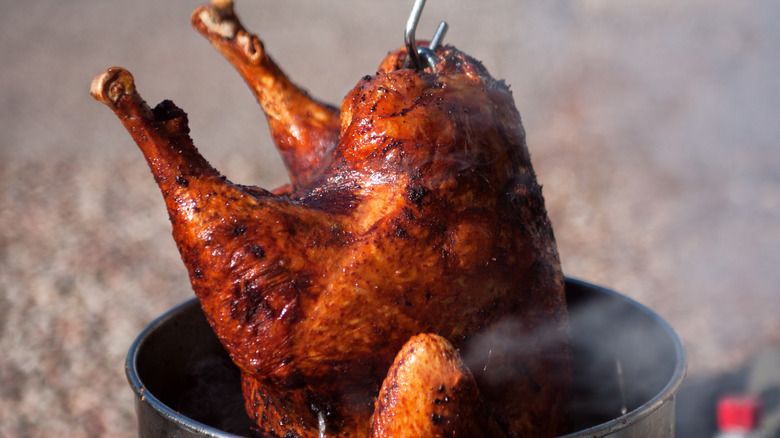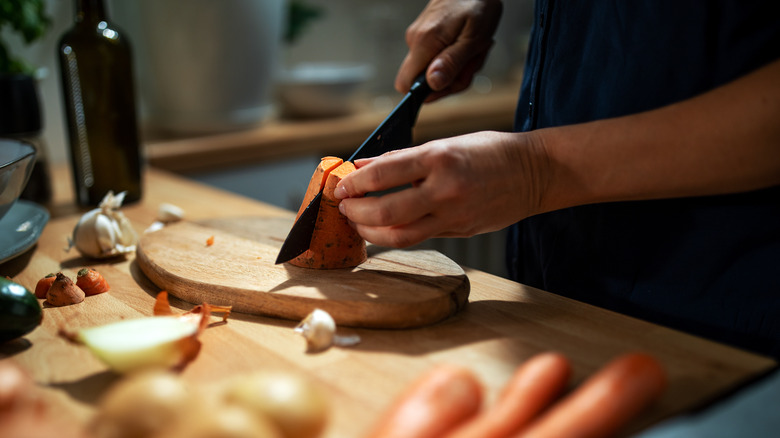Mistakes Everyone Makes With Stuffing: This Butterball Pro Has The Inside Scoop
We may receive a commission on purchases made from links.
This year, you're nailing the stuffing. It might seem like the one Thanksgiving side dish that you can phone in, but if you've spent your adult life loading up your plate with dense, flavorless lumps of mushy bread and thinking that's as good as it gets ... well, we've got some sizzling stuffing tips for you!
After putting out the call for expert help (kind of like the Batman symbol, but with the silhouette of a roasted turkey) Food Republic got the chance to chat with Butterball Turkey Talk-Line spokesperson Charla Draper who's been busy solving everyone's most pressing holiday cooking issues for the past 17 years. She's also served as a food editor for Southern Living and Ebony magazines, she founded National Soul Food Month which has been recognized every June for 22 years and counting — and Draper was honored by the Museum of Food and Drink (MOFAD) for her dedication in making African American culinary heritage an influential part of the national conversation. Needless to say, she certainly knows her stuff(ing). And with Draper's advice, you can go ahead and upgrade your own number to 1-800-LFTOVRZ.
No stuffing slip-up is too great for someone who's heard it all. From the best type of bread to use to the most flavorful ingredients and proper cooking temperature, these are the mistakes everyone makes with stuffing and the answers to cooking your best meal yet. Time to make this side dish the main event.
You always use the same type of bread for your stuffing
You're putting together a notoriously high-stress meal, where everything's riding on the stuffing-est stuffing of the year. (And if it goes wrong, you've gotta wait 365 days to try it again.) But if there's one step in your recipe that deserves a little grace — and even some extra imagination, if you're feeling it — it's choosing the best bread for your stuffing base.
Along with eggs, stock, juice, and sometimes alcohol, bread commonly serves as a binder for stuffing, holding together all the other ingredients you toss into the mix. But just because it's foundational to the recipe doesn't mean you have to worry that you might be using the wrong loaf. "When it comes to stuffing, all breads are equal!" declares Charla Draper from the Butterball Turkey Talk-Line. "Feel free to use any type of bread you prefer including white, whole grain, prepared croutons, or cornbread." While many recipes do call for a robust bread like sourdough, or baguette, cornbread elevates your Thanksgiving stuffing game by adding a hint of sweetness, absorbing all the succulent flavors from the other ingredients, and positively glowing with its golden, crispy crust. While you could incorporate the holy grail of breakfast for dinner by doing a Thanksgiving practice round stuffing featuring Belgian waffles, it's a relief to know this is one step where you really can't go wrong.
You didn't use stale bread for your stuffing
Yes you can upgrade boxed cornbread mix to make a sweet and savory stuffing (and heck yeah that could be a honey cornbread mix if you like). But if you're going with a fresh bakery loaf for your recipe, you'll want to be absolutely sure that bread is stale. (No need to make it awkward with the baker behind the counter. You can do this at home — in minutes.)
"Stale bread is ideal so you can achieve the best stuffing texture," says Charla Draper, founder of National Soul Food Month. And there's a little science behind why bread gets hard when it's stale. The chemical process is known as retrogradation, where the formerly highly-organized starch crystals — which got all discombobulated during the bake — begin to reform their original shapes and push all the moisture out of the loaf. While this is a total bummer for bread lovers any other time of the year, it's solid gold for Thanksgiving stuffing where balanced moisture is key. But wait — no need to get your croutons in a bunch over that fluffy French loaf sitting on your counter! There's an easy way to dry out bread that's too fresh. "If you don't have stale bread, you can still make a great stuffing," Draper explains. "Just toast the bread for a few minutes or place in the oven at 325 degrees Fahrenheit until it becomes crisp."
You didn't cook your stuffing ingredients ahead of time
You've scrolled the internet for a classic sausage and mushroom stuffing recipe, you've prepped your ingredients — and you're totally winning Thanksgiving this year, even with Aunt Deb's show-stopping cran-raspberry gelatin mold once again hogging the spotlight. But before you throw all those raw veggies and meats into the bowl with the breadcrumbs, give them a spin over some heat to leverage those seasonings.
"We suggest cooking the mix-ins before adding them to the stuffing to enhance their flavor and release extra nutrients," notes Butterball Turkey Talk-Line spokesperson Charla Draper. "For tender, moist stuffing, sauté vegetables for six to eight minutes or until they are crisp and tender before adding to your stuffing." Whether that means using Ina Garten's pro tip for caramelizing onions, cooking down your veggies for a spicy sourdough stuffing, or browning beef chuck for a Sicilian stuffing recipe, this step lends loads of flavor, minimizes extra moisture, and ensures all those tasty fillings will be fully cooked when you pull that stuffing out of the oven.
You accidentally doubled-up on seasoning in your stuffing
As we traverse the flavor tightrope between paper-like and salty-as-the-sea, we often find that the best-tasting foods perfectly match our peppery (or whatever your spice) preference. But even though you might be going light on the herbs de Provence, there's a chance you could be adding too much seasoning to your stuffing without even realizing it.
"If you are using ingredients higher in salt in your stuffing, be sure to watch how much additional seasoning you're adding in," advises Charla Draper, Butterball Turkey Talk-Line spokesperson and founder of National Soul Food Month. That includes that supremely savory center or thick-cut bacon waiting on the counter to be added to the bowl. Even breadcrumbs can come pre-seasoned. But you also want to watch out for under-the-radar sodium bombs like spice blends that often include salt, too. Draper adds, "While adding seasonings like thyme and pepper may be tempting, this can lead to an overly salty taste when paired with high sodium ingredients like ready-to-use broth. If you want to add salt and pepper to your stuffing, it's better to do so at the table than at the stove." Like you need another reason to bust out a pair of mason jar salt and pepper shakers for this year's masterful tablescape.
You didn't taste your stuffing to test for moisture
If you came for the stuffing this Thanksgiving, there are few revelations more disappointing than a recipe that turns out too dry (like it got even more stale in the oven), or one that becomes so dense it looks like a savory cousin of fruit cake. Want to keep your stuffing recipe from becoming crumbly or soggy? Taste test it for moisture before you bake.
First, make sure you're starting out on the right foot and not just winging it. Charla Draper, Butterball Turkey Talk-Line spokesperson, advises following a recipe to ensure consistency. She says, "There's nothing wrong with tasting your stuffing once all the ingredients are blended to see if it's too dry. If so, feel free to add more broth." (For the record, only the person cooking the stuffing shall be afforded this pre-dinner privilege. All other nibbly Nellies are officially banned from sticking their fingers in the bowl.) If you recall how you can moisten a dry turkey with a box of stock, you can double-down on those brothy benefits and enhance the flavor of your stuffing by swapping in stock instead of extra water. Draper explains, "Broth is a very important part of making stuffing! It's used to add flavor, moisten the bread and bind the ingredients together."
You didn't stuff your roasted bird
Unless you've been living under Plymouth Rock, you've probably heard the stuffing-in-the-turkey argument go hard in both directions over the years, with some landing on team stuff-the-bird and others forever baking stuffing on the side. But Charla Draper, spokesperson for Butterball Turkey Talk-Line, says she loves stuffed turkey. Sounds like she supports wherever your stuffing journey takes you.
If you do want to get the most out of stuffing your turkey, Draper's got some tips to make it a winning strategy. First, assemble your ingredients and prep your bird. "Prepare your stuffing using only cooked ingredients like sautéed vegetables, cooked meats or seafood," she shares. "Be sure to simply pat the turkey dry with paper towels instead of washing the turkey to prevent cross-contamination." While we all try to do as much Thanksgiving cooking as we can ahead of time, loading up your bird with fillings and storing it in the fridge shouldn't be one of them. "If you're going to stuff your turkey, do so right before you put it in the oven. Stuffing the night before could cause foodborne illness."
As for the best method for infusing your golden brown turkey with all those herby stuffing flavors, Draper offers some guidance on portioning. "Stuff both the neck and body cavities of a completely thawed turkey, allowing ½ to ¾ cup of stuffing per pound," she explains. And Draper points out that uneven cooking can be the result of stuffing that's packed too densely — so she encourages you not to do that.
You didn't cook your stuffing to a food safe temperature
Whether you like your stuffing straight from the belly of the bird, or topped with a toasty crust in its own casserole dish, you definitely want to cook that stuffing to a food safe temperature. And yeah, this one requires a thermometer.
"Take out your meat thermometer and make sure the stuffing registers an internal temperature of 165 degrees Fahrenheit," says Charla Draper, Butterball Turkey Talk-Line spokesperson and founder of National Soul Food Month. If that particular number sounds familiar, it's because it's the same temperature the USDA recommends for a fully cooked turkey. You can check your bird by taking its temp inside the meatiest part of the breast, inside the wing, and the most interior portion of the thigh. But just because your turkey's cooked doesn't mean the stuffing inside of it is. This is why Draper recommends pre-cooking all your stuffing ingredients (especially any meat or seafood), and then check your stuffing's temperature by sticking your thermometer right into its center. An oven safe thermometer works great for the turkey meat, but a digital cooking thermometer works best for a quick read on your stuffing in a hot oven. Once you're sure everything's safe to eat, it's all gravy from there.
You stuffed a deep-fried turkey and realized it too late
If you're reading this by the light of a deep-fried turkey fire blazing in your backyard, it might be a little too late. But just about any time before that, there's still a chance you can avoid stuffing a turkey that's destined for a vat of hot oil. Even if you're an expert at deep-frying the bird, it's best if you bake the stuffing by itself.
Butterball Turkey Talk-Line spokesperson Charla Draper recommends preparing (and cooking) stuffing separate from the bird if you're deep frying it — and the stuffing should be cooked in a baking dish. More than just a food safety issue, this is an occupational hazard warning since most of us prefer not to start off a long holiday weekend with a grease fire. Because the turkey cavity is hollow and open on both ends, any filling that previously seemed safe and secure in there will probably dislodge from the bird as soon as it hits the oil. (Don't forget to remove that gizzard. And you remembered that the giblets make great gravy, right?) That's not to say there aren't a few workarounds if you're craving deep-fried stuffing to go with a crispy-skinned bird. One method could involve pressing stuffing onto skinless turkey breast a la fried chicken fingers, and another might have you rolling cooked stuffing into balls which then get fried to a golden brown. By getting a little creative with your stuffing, you'll stay on theme and nobody has to call the fire department.
You went rogue on your stuffing mix-ins
A classic stuffing recipe technique can elevate almost any type of bread, a whole assortment of ingredients, and just about every herb you want to throw at it. The world is your oyster — uh, did we mention you can use oysters, too! But even though anything goes, not everything goes — at once.
Charla Draper, founder of National Soul Food Month, suggests that the best way to get the most bang for your buck with your stuffing is to stick to a tried and true recipe. While the holiday might be a great time to bust out a trendy family board game, or try a new Beaujolais you impulse-bought at the checkout, for most of us, it's definitely not the time to trust our hearts and throw a bunch of random stuff in a bowl with tons of bread cubes. (Cranberry brie pull-apart bread sounds great on its own. But will it in stuffing? Probably not.) The best recipes have been put to the test to guarantee the flavors and textures totally jam with each other and play well with other dishes you'll find on the table. Luckily, just about anything can become stuffing – whether you're craving a sausage and apple combo, buttery herbs, apricots, brown butter, pancetta, beer based broth, or all the grated cheese available, there's a stuffing recipe that'll be totally up your alley.
You didn't ask an expert about trying a new stuffing method
After nearly two decades spent solving Thanksgiving stuffing issues for callers on the Butterball Turkey Talk-Line, Charla Draper has seen — or heard — some things. And it sounds like we can all agree that if you have a question about stuffing this year, you're not the only one seeking expert advice.
"I've had folks ask if they can partially cook the turkey, then add stuffing and return the turkey to the oven," Draper recalls. And according to her, that'll be a definitive no. "This is not food safe; it combines foods at different temperatures and can create a food-related illness challenge!" (Um, most of us would probably rather have a slice of silky pumpkin pie for our after-dinner treat.) Without even a hint of judgment — even though she's probably answered every question hundreds of times — Draper empowers home cooks to craft a Thanksgiving feast to remember, no matter who is gathered around your table, what your real favorite dish might be, and how many years in a row that we forget to leave enough time to thaw the turkey. Maybe part of her success comes from offering a soothing voice on the other end of the line when all you want to do is throw in the towel and order takeout. Either way, this year's Thanksgiving stuffing is shaping up to be your best one yet. Just call 1-800-BUTTERBALL or text 844-877-3456 if you need some extra turkey day therapy.

